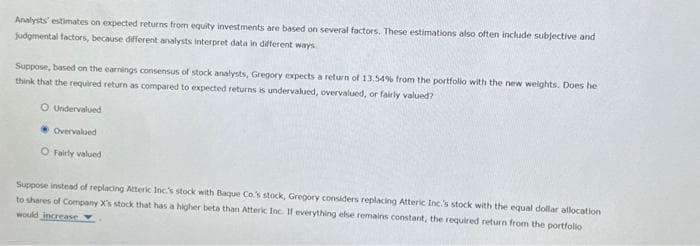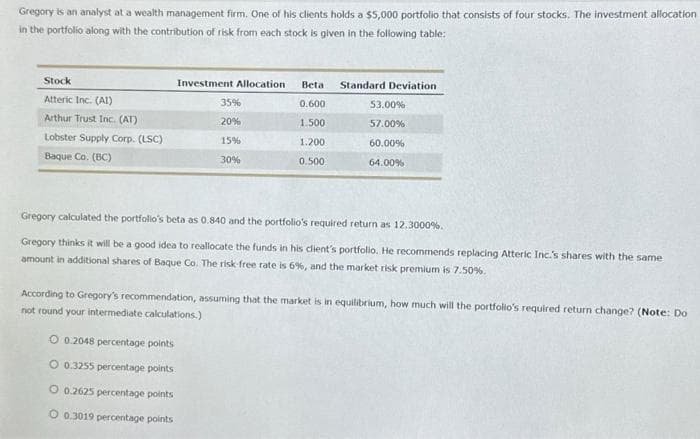Analysts' estimates on expected returns from equity investments are based on several factors. These estimations also often include subjective and judgmental factors, because different analysts interpret data in different ways Suppose, based on the earnings consensus of stock analysts, Gregory expects a return of 13.54% from the portfolio with the new weights. Does he think that the required return as compared to expected returns is undervalued, overvalued, or fairly valued? O Undervalued Overvalued O Fairly valued Suppose instead of replacing Atteric Inc.'s stock with Baque Co.'s stock, Gregory considers replacing Atteric Inc.'s stock with the equal dollar allocation to shares of Company X's stock that has a higher beta than Atteric Inc. If everything else remains constant, the required return from the portfolio would increase
Analysts' estimates on expected returns from equity investments are based on several factors. These estimations also often include subjective and judgmental factors, because different analysts interpret data in different ways Suppose, based on the earnings consensus of stock analysts, Gregory expects a return of 13.54% from the portfolio with the new weights. Does he think that the required return as compared to expected returns is undervalued, overvalued, or fairly valued? O Undervalued Overvalued O Fairly valued Suppose instead of replacing Atteric Inc.'s stock with Baque Co.'s stock, Gregory considers replacing Atteric Inc.'s stock with the equal dollar allocation to shares of Company X's stock that has a higher beta than Atteric Inc. If everything else remains constant, the required return from the portfolio would increase
Financial Management: Theory & Practice
16th Edition
ISBN:9781337909730
Author:Brigham
Publisher:Brigham
Chapter25: Portfolio Theory And Asset Pricing Models
Section: Chapter Questions
Problem 5MC: You have been hired at the investment firm of Bowers Noon. One of its clients doesnt understand the...
Related questions
Question

Transcribed Image Text:Analysts' estimates on expected returns from equity investments are based on several factors. These estimations also often include subjective and
judgmental factors, because different analysts interpret data in different ways
Suppose, based on the earnings consensus of stock analysts, Gregory expects a return of 13.54% from the portfolio with the new weights. Does he
think that the required return as compared to expected returns is undervalued, overvalued, or fairly valued?
O Undervalued
Overvalued
O Fairly valued
Suppose instead of replacing Atteric Inc.'s stock with Baque Co.'s stock, Gregory considers replacing Atteric Inc.'s stock with the equal dollar allocation
to shares of Company X's stock that has a higher beta than Atteric Inc. If everything else remains constant, the required return from the portfolio
would increase

Transcribed Image Text:Gregory is an analyst at a wealth management firm. One of his clients holds a $5,000 portfolio that consists of four stocks. The investment allocation
in the portfolio along with the contribution of risk from each stock is given in the following table:
Stock
Atteric Inc. (AI)
Arthur Trust Inc. (AT)
Lobster Supply Corp. (LSC)
Baque Co. (BC)
Investment Allocation
35%
20%
O 0.2048 percentage points
O 0.3255 percentage points
O 0.2625 percentage points
O 0.3019 percentage points
15%
30%
Beta Standard Deviation.
0.600
1.500
1.200
0.500
53.00%
57.00%
60.00%
64.00%
Gregory calculated the portfolio's beta as 0.840 and the portfolio's required return as 12.3000%.
Gregory thinks it will be a good idea to reallocate the funds in his client's portfolio. He recommends replacing Atteric Inc.'s shares with the same
amount in additional shares of Baque Co. The risk free rate is 6%, and the market risk premium is 7.50%.
According to Gregory's recommendation, assuming that the market is in equilibrium, how much will the portfolio's required return change? (Note: Do
not round your intermediate calculations.)
Expert Solution
This question has been solved!
Explore an expertly crafted, step-by-step solution for a thorough understanding of key concepts.
This is a popular solution!
Trending now
This is a popular solution!
Step by step
Solved in 5 steps with 7 images

Knowledge Booster
Learn more about
Need a deep-dive on the concept behind this application? Look no further. Learn more about this topic, finance and related others by exploring similar questions and additional content below.Recommended textbooks for you


Intermediate Financial Management (MindTap Course…
Finance
ISBN:
9781337395083
Author:
Eugene F. Brigham, Phillip R. Daves
Publisher:
Cengage Learning

Financial Reporting, Financial Statement Analysis…
Finance
ISBN:
9781285190907
Author:
James M. Wahlen, Stephen P. Baginski, Mark Bradshaw
Publisher:
Cengage Learning


Intermediate Financial Management (MindTap Course…
Finance
ISBN:
9781337395083
Author:
Eugene F. Brigham, Phillip R. Daves
Publisher:
Cengage Learning

Financial Reporting, Financial Statement Analysis…
Finance
ISBN:
9781285190907
Author:
James M. Wahlen, Stephen P. Baginski, Mark Bradshaw
Publisher:
Cengage Learning

EBK CONTEMPORARY FINANCIAL MANAGEMENT
Finance
ISBN:
9781337514835
Author:
MOYER
Publisher:
CENGAGE LEARNING - CONSIGNMENT